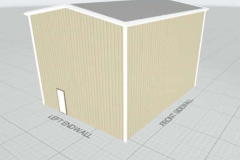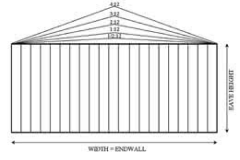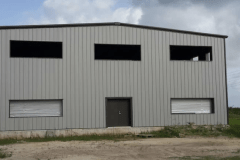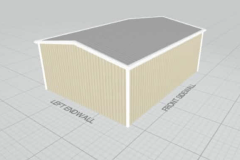Planning

Lets explore some planning tips for anyone who’s thinking about replacing their existing construction or building something entirely new from pre-engineered steel.
Before, we covered various stages in the planning process. Here, we’ll dive deeper into the planning stage by looking at both practical and legal factors that should be taken into consideration.
Practical Factors
Everyone needs to think about how they’ll use their new construction. For instance, a building being used as a warehouse will probably need high garage-like doors for larger vehicles to get through. All steel buildings need strong foundations. In most cases, concrete slabs are the perfect solution. However, there are times when alternative options will be more practical.
You’ll also have to think about the following when it comes to choosing a location for your building:
- Drainage capabilities
- Accessibility
- Level and firm ground
- Nearby utilities
- Space for future expansion
Take the next step
We have a passion for unconventional solutions that bring your vision to life.
Legal Factors
Your project will be subject to the building codes unique to your state. These codes dictate everything from the use of the building to construction requirements. It’s important to consult your local planning department prior to beginning because these codes are always subject to change. Anyone building a garage for emergency vehicles or a church might be subject to “important “factors” which raise these standards even higher than normal requirements.
Energy codes, drainage requirements, and zoning laws are some other examples of legal requirements you could be subject to. Some states enforce strict energy codes that require the implementation of “green” standards which work to reduce the carbon footprint of the construction. Using more insulation to conserve energy is one possible example. Although it’s a little bit more expensive at first, these insulation requirements are going to increase the energy-efficiency of your building over time. It might even end up paying for itself within the first year due to the reduction in cooling and heating costs.
Many parts of your building design will include both legal and practical considerations. For instance, retail facilities will have to, both practically and legally, offer parking with handicapped access.
Although some suppliers of metal buildings will help guide you through these complex building codes, most won’t even ship, fabricate, or even engineer buildings that aren’t compliant with the relevant requirements in your area. At the end of the day, it’s up to you to become familiar with these codes. If you don’t have experience in this area, don’t be afraid to talk directly with local contractors. The one who is the most helpful could even be brought on board as your erecting contractor when the building needs to go up. It can’t hurt to start talking with one.
Physical Building Factors
Building Orientation
The amount of sun and wind exposure your building gets each day might be an important factor to consider, although it all depends on your intended use. Will you want to design the building so that sunlight is pouring in throughout the day? Do you want to refrain from using doors and windows on one side of the building where the wind would be relentless? Maybe there’s an awesome view which you want to take advantage of. Those are just a few questions that you’ll want to think about when building.
Building Dimensions And Overall Size
It’s typically recommended that buyers of pre-engineered metal buildings opt for something bigger than their initial estimates. This suggestion derives from the natural process of growth. That way, you don’t have to spend money on additional space immediately after construction when your operation grows. It’s advisable to choose a size larger than you might initially think. Typically, dimensions for pre-built constructions are counted in 10s. For example, 40 feet x 50 feet or 50’ x 100’. However, you can get custom dimensions with minimal impact to the cost. 60×120, 50×100, 60×40, and 30×40 represent some of the more common sizes for metal buildings.
Building Height

The height of multi-story and single-story buildings are typically determined by local codes. However, those of community buildings will vary depending on the needs. Generally, a building’s eave height has to be a minimum of 2 feet higher in comparison to the tallest framed opening.
You’ll be able to determine the height of your building’s roof by the style and type of construction. For instance, aircraft hangars must use the high clearance offered by the clear span roof style. In order to achieve a feeling of spaciousness, churches might opt for high vaulted roofs. Normal roof height is typically sufficient for most office buildings.
Roof Pitch

A roof’s shape can be determined by the amount of space needed in the center of the room. The slope of a roof is represented through what’s known as the “roof pitch ratio”. This is expressed by the measure of rise for every foot of length. There is a colon in between these two measurements. For instance, a roof pitch of 1:12 or “one-in-twelve” has a slope that goes up two inches with every foot of horizontal length.
A 1:12 roof pitch is standard for most metal buildings and is nearly flat all the way across. 4:12 is normally the pitch measurement for gable-style buildings. A lot of space can be obtained for a little bit more money through the use of high-pitched roofs. If the extra space can be utilized, then the extra investment is definitely worth it. However, roofs with lower pitches have the advantage of being easier to cool and heat more easily. Depending on where you live, a roof pitch that’s steeper could be an added advantage because it sheds snow much easier than roofs with shallower slopes.
Framed Openings

A building that has any opening larger than the typical door frame has what’s known as a “framed opening.” These openings are typically very large so that big pieces of equipment, massive vehicles, and large stockpiles can fit through. A standard garage doorway is known as a framed opening. Factories, retail stores, and schools might also have a framed opening that’s used as a loading and unloading area.

